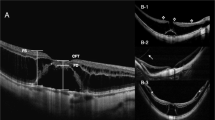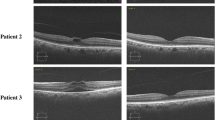Abstract
Purpose
The study aims to observe the spontaneous remission of posterior vitreous detachment (PVD)-type vision degrading myodesopsia (VDM) during long-term follow-up.
Methods
We retrospectively reviewed VDM patients with PVD type that refused any treatment. The ratio and time of significant spontaneous remission of floater symptoms occurring were described. The associated factors with significant remission of floater symptoms were analyzed in the univariate and multivariate logistic regression analyses.
Results
In total, 179 patients with VDM were assessed. The mean age of all patients was 60.56 ± 0.47 years old, and the mean duration of follow-up was 23.89 ± 6.63 months. Of the patients, 40.78% have significant improvement in their floater symptoms after mean 16.55 ± 10.63-month follow-up. Myopia (OR = 0.280, 95% CI = 0.084–0.932, P = 0.038), the number of floaters > 3 (OR = 0.343, 95% CI = 0.172–0.683, P = 0.002), and floaters with string-like pattern (OR = 0.370, 95% CI = 0.166–0.824, P = 0.015) and blocky pattern (OR = 0.299, 95% CI = 0.090–0.993, P = 0.049) were negatively correlated with the significant spontaneous remission of VDM symptoms in the multiple binary logistic regression analysis.
Conclusions
Approximately 40% of VDM patients with PVD may experience significant spontaneous remission during long-term follow-up. Patients that are non-myopic and with fewer floaters are more likely to feel relief from VDM symptoms. Floaters with string-like or blocky patterns are less likely to undergo spontaneous remission.





Similar content being viewed by others
Data availability
Raw data will be available upon request.
References
Webb BF, Webb JR, Schroeder MC et al (2013) Prevalence of vitreous floaters in a community sample of smartphone users. Int J Ophthalmol 6:402–405
Milston R, Madigan MC, Sebag J (2016) Vitreous floaters: etiology, diagnostics, and management. Surv Ophthalmol 61:211–227
Broadhead GK, Hong T, Chang AA (2020) To treat or not to treat: management options for symptomatic vitreous floaters. Asia Pac J Ophthalmol (Phila) 9:96–103
Shah CP, Heier JS (2017) YAG laser vitreolysis vs sham YAG vitreolysis for symptomatic vitreous floaters: a randomized clinical trial. JAMA Ophthalmol 135:918–923
Ludwig GD, Gemelli H, Nunes GM et al (2021) Efficacy and safety of Nd:YAG laser vitreolysis for symptomatic vitreous floaters: a randomized controlled trial. Eur J Ophthalmol 31:909–914
Lin T, Li T, Zhang X et al (2022) The efficacy and safety of YAG laser vitreolysis for symptomatic vitreous floaters of complete PVD or non-PVD. Ophthalmol Ther 11:201–214
Souza CE, Lima LH, Nascimento H et al (2020) Objective assessment of YAG laser vitreolysis in patients with symptomatic vitreous floaters. Int J Retina Vitreous 21(6):1
García BG, Orduna Magán C, Alvarez-Peregrina C et al (2020) Nd:YAG laser vitreolysis and health-related quality of life in patients with symptomatic vitreous floaters. Eur J Ophthalmol 7:11206721211008036
Ryan EH (2021) Current treatment strategies for symptomatic vitreous opacities. Curr Opin Ophthalmol 32:198–202
Schulz-Key S, Carlsson JO, Crafoord S (2011) Longterm follow-up of pars plana vitrectomy for vitreous floaters: complications, outcomes and patient satisfaction. Acta Ophthalmol 89:159–165
Shah CP, Fine HF (2018) Management of floaters. Ophthalmic Surg Lasers Imaging Retina 49:388–391
Wang MD, Truong C, Mammo Z et al (2021) Swept source optical coherence tomography compared to ultrasound and biomicroscopy for diagnosis of posterior vitreous detachment. Clin Ophthalmol 15:507–512
Tassignon MJ, Ní Dhubhghaill S, Ruiz Hidalgo I et al (2016) Subjective grading of subclinical vitreous floaters. Asia Pac J Ophthalmol (Phila) 5(2):104–109
van Overdam KA, Bettink-Remeijer MW, Klaver CC et al (2005) Symptoms and findings predictive for the development of new retinal breaks. Arch Ophthalmol 123(4):479–484
Delaney YM, Oyinloye A, Benjamin L (2002) Nd:YAG vitreolysis and pars plana vitrectomy: surgical treatment for vitreous floaters. Eye (Lond) 16:21–26
Chuo JY, Lee TY, Hollands H et al (2006) Risk factors for posterior vitreous detachment: a case-control study. Am J Ophthalmol 142:931–937
Smith TJ (1984) Dexamethasone regulation of glycosaminoglycan synthesis in cultured human skin fibroblasts. Similar effects of glucocorticoid and thyroid hormones. J Clin Invest 74:2157–2163
Smith TJ, Murata Y, Horwitz AL et al (1982) Regulation of glycosaminoglycan synthesis by thyroid hormone in vitro. J Clin Invest 70:1066–1073
Tsai WF, Chen YC, Su CY (1993) Treatment of vitreous floaters with neodymium YAG laser. Br J Ophthalmol 77:485–488
Su D, Shah CP, Hsu J (2020) Laser vitreolysis for symptomatic floaters is not yet ready for widespread adoption. Surv Ophthalmol 65:589–591
Katsanos A, Tsaldari N, Gorgoli K et al (2020) Safety and efficacy of YAG laser vitreolysis for the treatment of vitreous floaters: an overview. Adv Ther 37:1319–1327
Singh IP (2020) Modern vitreolysis-YAG laser treatment now a real solution for the treatment of symptomatic floaters. Surv Ophthalmol 65:581–588
Ivanova T, Jalil A, Antoniou Y et al (2016) Vitrectomy for primary symptomatic vitreous opacities: an evidence-based review. Eye (Lond) 30:645–655
Nguyen JH, Nguyen-Cuu J, Yu F et al (2019) Assessment of vitreous structure and visual function after neodymium:yttrium-aluminum-garnet laser vitreolysis. Ophthalmology 126:1517–1526
Shah CP, Heier JS (2020) Long-term follow-up of efficacy and safety of YAG vitreolysis for symptomatic weiss ring floaters. Ophthalmic Surg Lasers Imaging Retina 51:85–88
Hahn P, Schneider EW, Tabandeh H et al (2017) Reported complications following laser vitreolysis. JAMA Ophthalmol 135:973–976
de Nie KF, Crama N, Tilanus MA et al (2013) Pars plana vitrectomy for disturbing primary vitreous floaters: clinical outcome and patient satisfaction. Graefes Arch Clin Exp Ophthalmol 251:1373–1382
Mason JO 3rd, Neimkin MG, Mason JO 4th et al (2014) Safety, efficacy, and quality of life following sutureless vitrectomy for symptomatic vitreous floaters. Retina 34:1055–1061
Lin Z, Zhang R, Liang QH et al (2017) Surgical outcomes of 27-gauge pars plana vitrectomy for symptomatic vitreous floaters. J Ophthalmol 2017:5496298
Sommerville DN (2015) Vitrectomy for vitreous floaters: analysis of the benefits and risks. Curr Opin Ophthalmol 26:173–176
Appeltans A, Mura M, Bamonte G (2017) Macular hole development after vitrectomy for floaters: a case report. Ophthalmol Ther 6:385–389
Rubino SM, Parke DW 3rd, Lum F (2021) Return to the operating room after vitrectomy for vitreous opacities: intelligent research in sight registry analysis. Ophthalmol Retina 5:4–8
Serpetopoulos CN, Korakitis RA (1998) An optical explanation of the entoptic phenomenon of ‘clouds’ in posterior vitreous detachment. Ophthalmic Physiol Opt 18:446–451
Kalavar M, Hubschman S, Hudson J et al (2021) Evaluation of available online information regarding treatment for vitreous floaters. Semin Ophthalmol 36:58–63
Sebag J (2020) Vitreous and vision degrading myodesopsia. Prog Retin Eye Res 79:100847
Gishti O, van den Nieuwenhof R, Verhoekx J et al (2019) Symptoms related to posterior vitreous detachment and the risk of developing retinal tears: a systematic review. Acta Ophthalmol 97:347–352
van Overdam KA, Bettink-Remeijer MW, Mulder PG et al (2001) Symptoms predictive for the later development of retinal breaks. Arch Ophthalmol 119:1483–1486
Funding
This study was supported in part by the National Science Foundation of Liaoning Province, China (2020-MS-360), and Shenyang Young and Middle-aged Science and Technology Innovation Talent Support Program (RC210267). The funding organization had no role in the design or conduct of this research.
Author information
Authors and Affiliations
Contributions
T. Z. L.: research design, interpretation of data, critical revision of the manuscript, and final approval of the version to be published. X. Y., C. S., Q. L.: data acquisition and analysis and drafting the manuscript. E. E. P.: critical revision of the manuscript and data analysis. All authors read and approved the final manuscript.
Corresponding author
Ethics declarations
Ethics approval and consent to participate
All research methods are in accordance with the tenets of the Declaration of Helsinki and approved by the ethics committee Board of the He Eye Specialist Hospital. Written informed consent was waived due to the retrospective design.
Consent for publication
All authors concur with the submission and agree for publication.
Competing interests
The authors declare no competing interests.
Additional information
Publisher's note
Springer Nature remains neutral with regard to jurisdictional claims in published maps and institutional affiliations.
Rights and permissions
Springer Nature or its licensor (e.g. a society or other partner) holds exclusive rights to this article under a publishing agreement with the author(s) or other rightsholder(s); author self-archiving of the accepted manuscript version of this article is solely governed by the terms of such publishing agreement and applicable law.
About this article
Cite this article
Yang, X., Shi, C., Liu, Q. et al. Spontaneous remission of vision degrading myodesopsia of posterior vitreous detachment type. Graefes Arch Clin Exp Ophthalmol 261, 1571–1577 (2023). https://doi.org/10.1007/s00417-022-05948-4
Received:
Revised:
Accepted:
Published:
Issue Date:
DOI: https://doi.org/10.1007/s00417-022-05948-4




